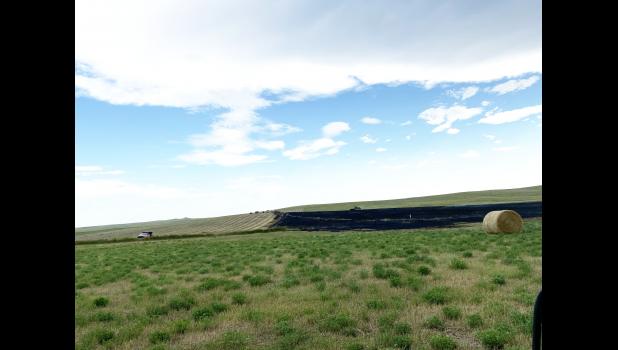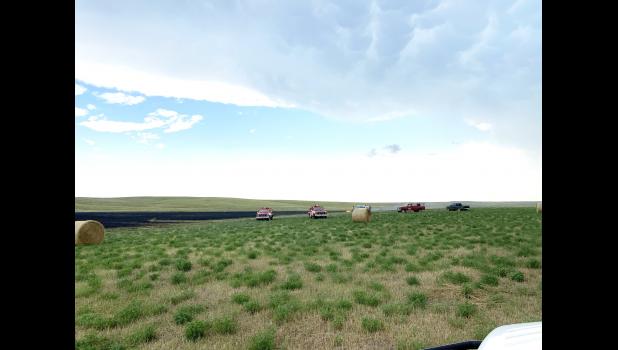Belvidere Volunteer Fire Department Respond to Belvidere Hay Fire
Wed, 07/29/2020 - 9:47am
admin
By:
Jenny Leibel
Belvidere Volunteer Fire Department responded to a report of a wildland fire, north of Belvidere on Community Well Road.
Upon arrival Firefighters observed a wind driven fire burning in a hayfield and a swather on fire. The fire caused damage to ranching assets, Firefighters controlled the fire to approximately 30 acres.
No injuries to Firefighters, Civilians or domestic animals were reported.
What Causes Hay Fires?
Hay fires usually occur within six weeks of baling, but they may occur in hay several years old. Fire can occur in loose hay, small bales, large bales or in stacks. The fires can occur in hay stored inside as well as in hay stored outside. Regardless of when or where the fires occur, the most common cause is excessive moisture.
Freshly cut forage materials are not dead. Some respiration continues and a very small amount of heat is produced. This heat generated by respiration is probably of little consequence except that it may help provide proper conditions for growth of bacteria. As the moisture content of the crop decreases during the curing process, respiration will slow and eventually cease.
Forage crops are always contaminated with countless microorganisms. These microorganisms are no problem when the hay is harvested and cured to the proper moisture content before baling and storage. After baling, however, a small supply of air and a favorable moisture level cause the microorganisms to begin to feed and multiply, generating heat in the process. This heating continues up to a temperature of 130 to 140°F, at which the heat tends to kill the microorganisms.
Depending upon the exact conditions, the temperature may decrease slowly at this point as the microorganisms are killed. The hay may go through several similar heating cycles during the next weeks as the population of microorganisms increases and decreases, but the highest temperature will usually be lower each time. Eventually the temperature will stabilize near the ambient temperature.
No fire results in a case like the one described above, but there may be considerable heat damage to the hay. In some cases cows may actually prefer the taste of the brown, heat-damaged hay but the feed has decreased considerably in nutritional value.
The thermophilic bacteria and the heat they generate convert the hay to a form similar to a carbon sponge with microscopic pores. In this form and at the high temperatures present in heated hay, the material combines readily with oxygen. It can self-ignite in the presence of air and its tendency to burn is almost unbelievable.
Preventing Hay Fires
Since the moisture content of hay is a key factor in microbial activity and the resultant heating, it is important that the crop be cured to the proper moisture content before baling.
Weather conditions greatly influence the rate at which the crops dry. Ideal hay curing weather has less than 50 percent relative humidity and some wind. Be aware that the moisture content of the hay will increase overnight when the air is humid, especially if there is dew or fog. Monitor weather forecasts carefully to help schedule haymaking operations.
Conditioning equipment which crimps or abrades the crop stems is helpful because it speeds the drying process. Using tedders or hay rakes to very gently fluff windrows may also speed the curing process.
Chemicals such as drying agents and preservatives, when properly used, may be advantageous with some crops, such as high quality alfalfa. Correct application is essential to avoid potential problems.
New hay which is stacked in the field or placed in a barn should be checked frequently for possible heating. At first, check in the morning and afternoon. If no signs of abnormal heating are found, the intervals may be lengthened. If the temperature reaches 130°F, move the hay to allow increased air circulation and cooling.
Hay which is to be stored uncovered outdoors (big round bales and stacks) should be formed into the tightest packages possible to resist penetration by rain. Do not place unprotected bales or stacks tightly against each other. Instead, place the bales where air can circulate freely. Protect the bales from ground moisture and runoff by placing them on a bed of gravel, old tires, poles or pallets. Plastic or other waterproof covers will protect bales by shedding precipitation.
If storing hay inside, be sure the barn roof and any plumbing do not leak. Likewise, provide adequate drainage so water will not enter the barn during storms. Hay may be at the proper moisture content when baled and stored, but wetting from a leak can allow bacterial activity to increase and result in a fire.
There are, of course, causes of hay fires other than spontaneous ignition. Some of these causes are lightning striking nearby trees or fences, arson, contact with electric fences and sparks from cigarettes, welding or nearby fires.
Controlling A Hay Fire
If you detect temperatures above 175°F, a fire is imminent or one is nearby. The smell or sight of smoke means a fire is definitely present. In any of these cases, call the fire department immediately.
Do not move any of the hay. This would expose the overheated or smoldering hay to oxygen and may result in a fire raging out of control.
The firefighter operating the probe should wear full turnout gear, lifeline and a SCBA. Steam may blow back along the probe or through other openings when water reaches a fire. Boards, plywood or a ladder should be used to distribute the person's weight and prevent falling into a burned-out cavity
Another firefighter should assist from a safe location nearby. This person should also wear full turnout gear and should have a charged hose ready in addition to the hose needed for the probe.
When it is believed that the hot spots have been sufficiently cooled, begin removing the hay from the barn or stack. Keep a charged hose ready and manned to quickly control any blazing that may result from missed or insufficiently cooled hot spots.
Hay fires are burdensome. Not only can they injure or even kill, but they are also a financial burden. They can harm buildings, livestock, crops and even other hay. Even a single hay fire, when it’s all said and done, can result in hundreds of thousands of dollars in total damages. With this in mind, it is necessary to understand what causes hay fires and how to prevent them from happening.
Firstly, hay fires are most typically caused by spontaneous combustion. While this might make it seem like hay fires are unpredictable—and, to some extent, they are—there are still ways to prevent this spontaneous combustion from occurring, or at least to lower the chances of this happening.
The key to preventing hay from combusting is to monitor its percent moisture. The wetter hay is, the more likely it is to combust. When a high percentage of hay is moisture, the hay begins to heat, and the high moisture reduces the hay’s insulation ability. Hay that is above 15 percent moisture, the hay begins to heat. Therefore, it is important to keep the hay’s percent moisture in check. A good rule of thumb is to keep smaller hay bales at a percent moisture of 18 to 22 percent and larger ones at a percent moisture between 16 and 22 percent.
In addition to keeping hay appropriately moist, it is also key to monitor the temperature of the hay, especially if it seems that the hay might be heating up. Generally, if the hay ever reaches 150 degrees Fahrenheit, then it is vital to check temperature daily—as hay that is hotter than this is susceptible to combust. At 160 degrees, the hay is in danger of combusting, and the hay should be inspected once every four hours.
Once the hay gets to 175 degrees, a fire is imminent. To prevent this, wet down the hay, call the fire department and dismantle hay stacks and keep them away from buildings and other (especially dry) hay.
Oftentimes, hay is treated with preservatives, so it is important to examine the consequences of this. Certain preservatives cause hay to produce hydrogen cyanide when heated to above 240 degrees. In this case, extra caution is necessary—as hydrogen cyanide is lethal. In addition, salt, while it may extend the hay’s shelf life, does not prevent spontaneous combustion, but substances like dry ice, liquid nitrogen and gaseous carbon dioxide do.
In the end, preventing spontaneous combustion in hay boils down to vigilance. And this vigilance certainly pays off, as it will not only make people and property safer, but it will maintain the quality of the hay.


